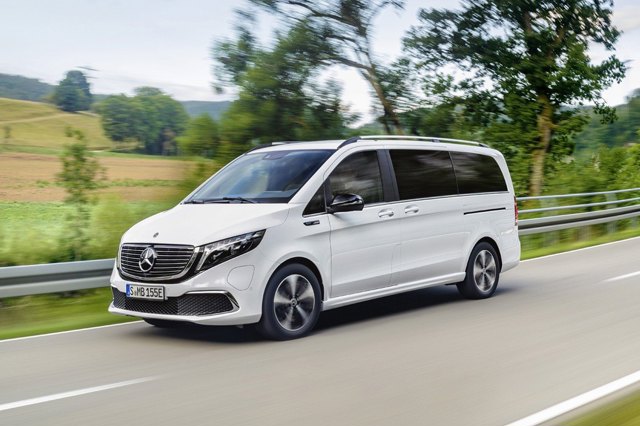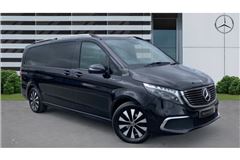August 2019
Mercedes-Benz EQV unveiled
The technical highlights include a range of 252 miles (provisional figures) and the rapid charging of the high-voltage battery from 10 to 80 per cent in less than an hour.
The electric drive train (eATS) of the Mercedes-Benz EQV is situated on the front axle under the front end of the car with a charging connection in the bumper. It has a peak output of 150kW. The electric motor, the transmission with a fixed gear ratio, the cooling system and the power electronics constitute a highly integrated, compact unit. The power is provided by a lithium ion battery under the floor of the vehicle. Its low, central location also has a positive effect on the handling characteristics of the EQV.
The refinement of MBUX specifically for EQ is a particular highlight. In the high-resolution, ten-inch media display, the EQ tile in the main menu serves as a central point of access to the specific displays and settings. These include the charging current, departure time, energy flow and consumption histogram. The media display can also be used to operate the navigation and Mercedes me Charge functions, as well as the driving modes.
To ensure that the technical operating range is used to the maximum, the Mercedes-Benz EQV also charges its batteries when on the move. When accelerating or braking, the mechanical rotation is converted into electrical energy and used to charge the high-voltage battery (recuperation). The driver has a major influence on recuperation. He/she is also able to influence the recuperation level using paddles behind the steering wheel. The paddle on the left increases the level of recuperation, the paddle on the right reduces it. At the weakest level the vehicle "coasts", while at the strongest level it is possible to drive using a single pedal. This is because, in most situations, the slowing effect of recuperation is sufficient to make the brake pedal redundant.
The recuperation level D Auto reflects the intelligence of the EQV. The automatically activated ECO Assistant helps the driver to achieve the best possible efficiency. It combines navigation data, road traffic sign recognition and information provided by the intelligent safety assistance systems (radar and camera), and adjusts the level of recuperation itself.
In combination with EQ-optimised navigation, active range monitoring ensures that the driver reaches the destination safely even if a charging stop is missed. It is also assisted by the E+ driving mode, which optimises the vehicle's parameters to maximise the range.
With the Mercedes-Benz Wallbox Home and 11kW charging output, the EQV can be charged significantly faster than using a domestic socket. In cooperation with country-specific charger installation partners, Mercedes-Benz also offers easy and rapid installation of the Mercedes-Benz Wallbox and professional advice on all aspects of e-mobility. DC charging using the series-standard CCS (Combined Charging Systems) is even faster. In Europe the EQV can be charged with a maximum output of up to 110 kW at an appropriate charging station. It then takes much less than an hour to charge from 10 to 80 per cent SoC.
|
CO 2 emissions
|
0 g/km
|
|
Electrical combined
|
27,0 kWh/100 km (provisional figures) 1
|
|
Range
|
405 (provisional figures) 1
|
|
Charging time at a Wallbox or at public charging stations (AC charging, 11 kW)
|
<10h
|
|
Charging time at a fast charging station (DC Charging, 110kW)
|
10-80% SOC in <45 min
|
|
Drive system
|
Front-wheel drive
|
|
Output
|
150 kW (204 hp)
|
|
Peak torque
|
362 Nm
|
|
Top speed
|
160 km/h
|
|
Battery
|
Lithium-ion
|
|
Battery energy content (installed)
|
100 kWh
|
|
Battery energy capacity
(usable)
|
90 kWh
|
|
Length/width (incl. mirrors)/height:
|
5,140 mm (5,370 mm)
|
|
Wheelbase
|
3,200 mm (3,430 mm)
|
|
Luggage compartment (depending on equipment fitted)
|
1030 l
|
|
GVW
|
3500 kg
|








 Available as a six, seven or eight-seater, will cover 252 miles on a single charge, exempt from Congestion Charge fees.
Available as a six, seven or eight-seater, will cover 252 miles on a single charge, exempt from Congestion Charge fees.
 Prices expected to start at £60,000, not available until late 2020.
Prices expected to start at £60,000, not available until late 2020.
